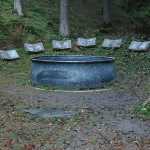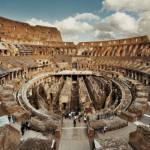 Technology
Technology  Technology
Technology  Humans
Humans 10 Everyday Human Behaviors That Are Actually Survival Instincts
 Animals
Animals 10 Animals That Humiliated and Harmed Historical Leaders
 History
History 10 Most Influential Protests in Modern History
 Creepy
Creepy 10 More Representations of Death from Myth, Legend, and Folktale
 Technology
Technology 10 Scientific Breakthroughs of 2025 That’ll Change Everything
 Our World
Our World 10 Ways Icelandic Culture Makes Other Countries Look Boring
 Misconceptions
Misconceptions 10 Common Misconceptions About the Victorian Era
 Mysteries
Mysteries 10 Strange Unexplained Mysteries of 2025
 Miscellaneous
Miscellaneous 10 of History’s Most Bell-Ringing Finishing Moves
 Technology
Technology Top 10 Everyday Tech Buzzwords That Hide a Darker Past
 Humans
Humans 10 Everyday Human Behaviors That Are Actually Survival Instincts
 Animals
Animals 10 Animals That Humiliated and Harmed Historical Leaders
Who's Behind Listverse?

Jamie Frater
Head Editor
Jamie founded Listverse due to an insatiable desire to share fascinating, obscure, and bizarre facts. He has been a guest speaker on numerous national radio and television stations and is a five time published author.
More About Us History
History 10 Most Influential Protests in Modern History
 Creepy
Creepy 10 More Representations of Death from Myth, Legend, and Folktale
 Technology
Technology 10 Scientific Breakthroughs of 2025 That’ll Change Everything
 Our World
Our World 10 Ways Icelandic Culture Makes Other Countries Look Boring
 Misconceptions
Misconceptions 10 Common Misconceptions About the Victorian Era
 Mysteries
Mysteries 10 Strange Unexplained Mysteries of 2025
 Miscellaneous
Miscellaneous 10 of History’s Most Bell-Ringing Finishing Moves
10 Surprising Ways Modern Visitors Have Harmed Historic Sites
One often-heard argument for welcoming visitors to historic sites is that the money they spend will pay for the site’s upkeep. However, this is not without risk. Whether by accident or in a bout of what has become known as “main character syndrome,” it seems that visitors cannot help but harm the places they go, sometimes in bizarre ways that are impossible to predict. This list shares ten of the most unusual ways important sites have been damaged.
Related: Top 10 Attractions To Visit For A Weird Tour Of Europe
10 Stuffing Coins in Giant’s Causeway
With its thousands of basalt columns jutting out into the sea, Giant’s Causeway in Northern Ireland is one of the world’s most recognizable natural sites. It has survived for around 60 million years. However, a common practice among recent visitors has put the prospect of it lasting another 60 million in doubt. The practice in question is jamming coins in the narrow gaps between the rocks.
Many of the hundreds of thousands of visitors who make their way to the Causeway each year do this, oblivious to the harm they are causing. When the coins rust, they become around three times thicker, forcing the columns apart and causing them to crumble. They also leave unsightly streaks on the rocks as they corrode, and people might also chip the rocks while placing the coins. There are so many that removing them could cost as much as $40,000.[1]
9 Carving Graffiti in the Colosseum
The people leaving coins at Giant’s Causeway do so in the belief that it will bring them luck or love. They are also probably unaware of the harm the coins cause when they rust. Their behavior is selfish but perhaps excusable. The same cannot be said for people who carve their names or initials into historic sites. One venue that has become infamous for people attempting to do this is the Colosseum in Rome.
To discourage these narcissists, the Italian authorities threaten them with thousands of dollars in fines and prison sentences of up to five years for defacing the 2,000-year-old amphitheater, yet some people still try. In 2023, stunned onlookers filmed and confronted a tourist who was carving names into the Colosseum’s walls. It was the fourth report of graffiti there that year. The tourist caught on camera was widely criticized online and was required to pay €965 to repair the damage.[2]
8 Stealing Cobblestones from Bruges’ Streets
Historical sites are not only harmed by the things visitors leave behind but also by what they take. Anywhere that welcomes a large number of visitors will end up with a few who feel entitled to a free souvenir. Few cities know this better than the beautiful medieval city of Bruges in Belgium. Surprisingly, it is not chocolates that the thieves have set their sights on, but stones.
The streets of Bruges are lined with cobblestones, which add to the city’s old-world charm. However, according to one of the city’s politicians, between 50 and 70 stones are stolen each month, and the figure can be even larger during the high season. He highlighted how the thieves were not just being disrespectful towards the city’s heritage and other visitors who may wish to enjoy it, but they were also creating tripping hazards.[3]
7 Grabbing Great Wall Bricks
Tourists are not always the culprits when it comes to stealing from historic sites. In the 1960s and 1970s, it was common for Chinese villagers in areas around the Great Wall to build houses from its bricks. This is one of the reasons that around 30% of the Wall is believed to be missing today. Erosion and damage caused by tourists are also thought to be major factors in the Wall’s decline.
Despite the 2006 outlawing of the theft of bricks, local attitudes took a long time to change. It proved difficult to enforce the rules and stop poor villagers from stealing the bricks to build or sell as souvenirs. However, by 2016, awareness of the need to protect the Wall had grown in many areas, and some residents took to gathering up fallen bricks and saving them for future repairs.[4]
6 Pinching Petrified Wood
While China had some luck convincing local residents to stop raiding the Great Wall, other authorities’ efforts to curtail theft have had the opposite effect. One example even became the subject of a psychological study. The place in question is the Petrified Forest National Park in Arizona. Scattered across its Martian landscape are countless logs and stumps of trees that died millions of years ago but which have been preserved in volcanic ash. Some are small enough to make compelling souvenirs.
Visitors are not actually allowed to take the wood home, yet many do. To discourage this, the park authorities have put up signs informing people of the amount of wood taken each year. However, psychologist Robert Cialdini thought this might be doing more harm than good because it inadvertently tells visitors that everybody steals. He tested two versions of the signs and found that one, which simply asked visitors not to steal the wood, was several times more effective.[5]
5 Climbing the Kukulkan Pyramid
Sometimes, it is not visitors taking or leaving anything that harms historic sites but rather the actions of those who are already there. Simple wear and tear is also a serious issue. It is easy to forget that places like the Pyramid of Kukulkan in Mexico also have to withstand the elements and the ravages of time. Thousands of visitors climbing its 365 steps each year, on top of that, can only speed up the rate at which it is being chipped away.
That is why climbing the pyramid, which is part of the ancient Chichen Itza city-state, was outlawed in 2008. Once they have caught their breath after the treacherous 91-step climb to the top, violators face fines of up to $16,000 and as many as 10 years in prison if they cause damage. Still, some try, although locals and other visitors have been known to dish out their own justice to them, too.[6]
4 Rubbing Breasts in Verona
The impact of thousands of feet traipsing up and down is one way to erode a solid structure, but it can also be done by thousands of hands rubbing the same spot. This is an issue that has affected the Italian city of Verona, where Shakespeare set his tragic tale of teen love, Romeo and Juliet. Not once, but twice, has a famous statue of Juliet in the city been damaged by the constant onslaught of sweaty hands.
Compared to the other sites on this list, the statue is not even particularly old. It was only in its fifth decade when it was first replaced in 2014, and the second version lasted just ten years before a hole formed. Somehow, in those relatively few years, word spread far and wide that rubbing Juliet’s breasts would bring people luck in relationships, causing hundreds of visitors to take part in the strange ritual every day.[7]
3 Peeing on Ulm Minster
Another highly effective method of eroding something hard is to apply acids and salts to it, which lots of men have inadvertently been doing to the world’s tallest church. By 2016, the German city of Ulm was having so much trouble stopping men from peeing on the walls of Ulm Minster that they increased police patrols in the area and doubled fines for those caught. However, these measures had no effect.
The increased efforts to clamp down on those who pee on the church came after costly restorations were made to its sandstone base. While it is unclear whether these were required due to urine damage, one city spokeswoman seemed to suggest that it was a perennial problem. With the church’s foundations laid all the way back in 1377, it is possible that people have been engaging in this practice for centuries, causing significant harm.[8]
2 Pooping on Herculaneum
It will probably be a relief to hear that the visitors whose number twos were slowly wrecking the ancient town of Herculaneum were not humans but pigeons. The problem is that their droppings are not only unsightly but also highly acidic, posing a real threat to ancient structures and surfaces. By the early 2000s, so many birds had nested in the Roman-era settlement that the authorities were compelled to take action.
In 2005, to preserve what remained of the town after the eruption of Mount Vesuvius in AD 79, officials brought in three Harris hawks to chase the pigeons away. While it might seem like bringing more birds to the area was a strange move, hawks had been used in the past to chase pigeons away from Italian airports.[9]
1 Breathing on Cave Paintings
Sometimes, the mere presence of people is enough to cause irreversible damage to a historic site, even if they are just standing still. This is why visitors who head to Lascaux, France, to see the famous prehistoric cave paintings do not actually get to see the real thing. Instead, they are taken to a replica built next door.
The real cave was only open to the public for a brief period between the end of the Second World War and 1963. It was closed off when concerns were raised that the breath and sweat of visitors were making the cave too humid for the paintings to last. The dry atmosphere and steady temperature inside the cave were the reasons the paintings were so well-preserved over the 20,000 years preceding their rediscovery in 1940.[10]








